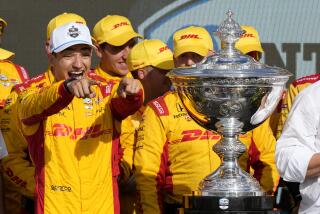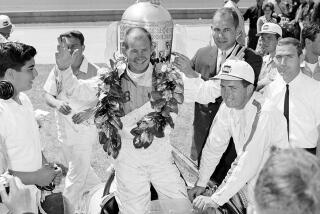Brayton Dies at Indy
INDIANAPOLIS — Scott Brayton, one of the most popular drivers at Indianapolis Motor Speedway, was killed Friday while practicing for the Indianapolis 500 on May 26, in which he would have been the pole-sitter.
Brayton, 37, was driving a backup machine, car No. 23, testing engine functions for Team Menard, when the right rear tire appeared to deflate, sending the 1,550-pound Lola-Menard into a slow spin as it entered the second turn.
Like a whip being cracked, the car suddenly changed directions, shot across the track and hit the outside wall on the left side. It slid along the wall before coming to a stop in the middle of the backstretch.
Brayton was unconscious when he was removed from the badly damaged car and was taken to Methodist Hospital, where he was declared dead 33 minutes after the accident.
The crash came with stunning suddenness after one of the safest pre-race periods in Indy 500 history. Only two cars had hit the wall, with neither driver badly injured, before Brayton’s accident, and he was the most experienced driver here, with 14 previous 500 starts.
He was running 230 mph, speeds only elite drivers ever attain, and he was doing it on the track he loved best.
It was Brayton’s turn to test the Menard “mule” car--identical to the four qualified cars--a duty he shared with his teammates: Eddie Cheever and rookies Tony Stewart and Mark Dismore. Brayton had run 52 laps Friday, with a top speed of 230.126 mph when disaster struck.
On the lap before the crash, he was clocked at 228.606, and through the speed trap on the straightaway at 234 mph.
U.S. Auto Club technical committee investigators said there was “conclusive evidence to support the report that rapid deflation of the right rear tire occurred, causing Scott’s [car] to spin into the outside wall in Turn 2.”
Tony Troiano, a spokesman for Firestone tires, on which Brayton was riding, said, “Our preliminary analysis tends to indicate the right rear tire did lose air, but the manner in which it occurred leads us to believe the tire was cut. We are continuing to analyze what we have left of the tire, and that analysis does not indicate any internal structural damage.”
Brayton was a happy-go-lucky man, always smiling, always ready to chat about racing. When reporters approached him for a story, it wasn’t an interview, it was a conversation.
When he wasn’t on the track, or discussing racing with anyone who would listen, he was usually strolling around the Speedway grounds, hand-in-hand with his wife, Becky, or carrying their daughter, Carly, 2 1/2.
“We’re very saddened by Scott’s death,” said Tony George, Speedway president. “He has been a great ambassador for the sport. His family has put its entire heart and soul into automobile racing. There was so much love in the family.
“Scott expressed to me earlier in the month on a couple of different occasions how much he loved his two girls--Becky and Carly. We’re going to miss him. He died doing what he loved best, going fast at Indianapolis Motor Speedway. There’s not much more that can be said than that.”
Brayton’s father, Lee, himself a former Indy car driver and engine builder, put Scott into a go-kart on his fifth birthday. The Braytons live in Coldwater, Mich., about 180 miles north of the Speedway.
The announcement of Brayton’s death to reporters, and to the spectators watching the final day of serious practice before next Thursday’s carburetion day, was delayed nearly three hours until his mother could be notified.
“Today I lost a great friend, a great husband, a great father and a great competitor,” said John Menard, Brayton’s car owner. “Words can’t describe what I’m feeling now. Scott just loved this place. He loved to go fast here, he loved the pole. It was a gutsy thing he did last Saturday.”
In pole qualifying last Saturday, Brayton made one of the most dramatic moves in Indianapolis 500 history, when, after qualifying for the second row of the race, he withdrew his car and got into another Menard car to try to take the pole from Arie Luyendyk.
Brayton did it, turning four laps at a record 233.718 mph.
“Scotty had a perfect race car, a perfect day and a perfect track, and it reached out and bit him,” Menard said. “It reminds you that this is a very serious business.”
Jack Long, Indy Racing League executive director, said, “There couldn’t have been a more experienced driver in a more proven and reliable car. It’s just unfathomable it could happen to him.”
The doors of Menard’s eight side-by-side garages were closed. The only thing moving was an American flag waving in front of the garage that held Brayton’s car.
In another moving tribute, the Speedway put No. 32 at the top of the 97-foot scoring pylon and turned the lights off on all the other numbers.
The circumstance moves Stewart, Brayton’s teammate, onto the pole for the 500. Davy Jones moves to the inside and Chilean Eliseo Salazar, only recently recovered from serious leg injuries suffered in a racing accident earlier in the year, moves up to the outside of the front row.
Menard said that no decision will be made on the No. 2 car, the one Brayton qualified. It can be started by another driver from the rear of the pack, or it can be withdrawn.
It would have been the second consecutive 500 in which Brayton started on the pole. He had started in the middle of the front row in 1985, the only time in 14 Indy 500s that he led a lap.
Until the Indy Racing League series was formed this year, Brayton drove only at Indianapolis the past two years. Since driving in his first Indy car race in 1981 at 22, he drove 157 races without winning. His best finish was a third at Milwaukee in 1992.
His best finishes at Indy were sixths in 1989 and 1993, the only year he completed the 200 laps.
“It’s really hard to see a friend die,” said Jonathan Byrd, an Indianapolis restaurateur who owned the car Brayton drove in 1993. “It’s something we expect as a risk in this sport, but it doesn’t make it any easier. I know Scott would want us to go on, but that doesn’t make it any easier either.”
Before joining the Menard team in 1994, Brayton drove seven years for Dick Simon’s team. Brad Amster of Orange handled the team’s public relations.
“I couldn’t believe it when I heard the news,” Amster said. “It just can’t be true. I virtually lived with him for six racing seasons, and the thing I remember most is that everybody he met liked him. He was a press agent’s dream. He loved meeting people and after they met him, they loved him.”
Brayton was the 39th driver to die since the Speedway was opened in 1909, two years before the first Indianapolis 500.
The last fatality was in 1992 when rookie Jovy Marcelo of the Philippines hit the wall during practice in an accident remarkably similar to Brayton’s.
More to Read
Go beyond the scoreboard
Get the latest on L.A.'s teams in the daily Sports Report newsletter.
You may occasionally receive promotional content from the Los Angeles Times.










